Daylength and circadian effects on starch degradation and maltose metabolism
- PMID: 16055686
- PMCID: PMC1183414
- DOI: 10.1104/pp.105.061903
Daylength and circadian effects on starch degradation and maltose metabolism
Abstract
Transitory starch is stored during the day inside chloroplasts and broken down at night for export. Maltose is the primary form of carbon export from chloroplasts at night. We investigated the influence of daylength and circadian rhythms on starch degradation and maltose metabolism. Starch breakdown was faster in plants of Arabidopsis (Arabidopsis thaliana) ecotype Wassilewskija growing in long days. Transcript levels of genes encoding enzymes involved in starch degradation and maltose metabolism showed a strong diurnal rhythm. Under altered photoperiods, the transcript levels and the rate of starch degradation changed within one day/night cycle. However, the amount of proteins involved in starch degradation was maintained relatively constant throughout the day/night cycle. To investigate whether the diurnal cycling of the transcript levels is only a response to light or is also regulated by a circadian clock, we measured the amount of messenger RNAs in Arabidopsis leaves under continuous light and continuous darkness. The expression of genes encoding starch degradation-related enzymes was under very strong circadian control in continuous light. Under continuous light, the amount of maltose also showed a strong endogenous rhythm close to 24 h, indicating that maltose metabolism is under circadian control. Light is necessary for the cycling of transcript levels and maltose levels. Under continuous darkness, these genes were barely expressed, and no cycling of maltose levels was observed.
Figures
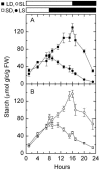

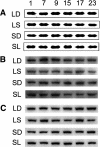
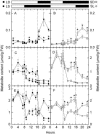
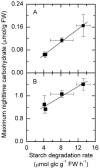
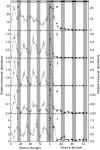

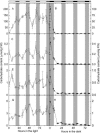
References
-
- Alabadi D, Oyama T, Yanovsky MJ, Harmon FG, Mas P, Kay SA (2001) Reciprocal regulation between TOC1 and LHY/CCA1 within the Arabidopsis circadian clock. Science 293: 880–883 - PubMed
-
- Borland AM, Taybi T (2004) Synchronization of metabolic processes in plants with Crassulacean acid metabolism. J Exp Bot 55: 1255–1265 - PubMed
-
- Chandler JW, Apel K, Melzer S (2001) A novel putative β-amylase gene and ATβ-Amy from Arabidopsis thaliana are circadian regulated. Plant Sci 161: 1019–1024
-
- Chatterton NJ, Silvius JE (1980) Photosynthate partitioning into leaf starch as affected by daily photosynthetic period duration in 6 species. Physiol Plant 49: 141–144
Publication types
MeSH terms
Substances
Associated data
- Actions
LinkOut - more resources
Full Text Sources
Molecular Biology Databases

